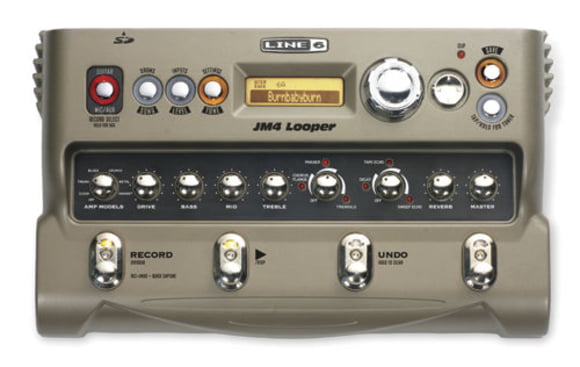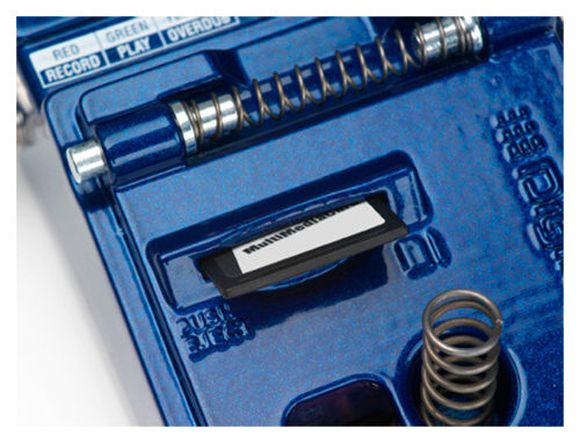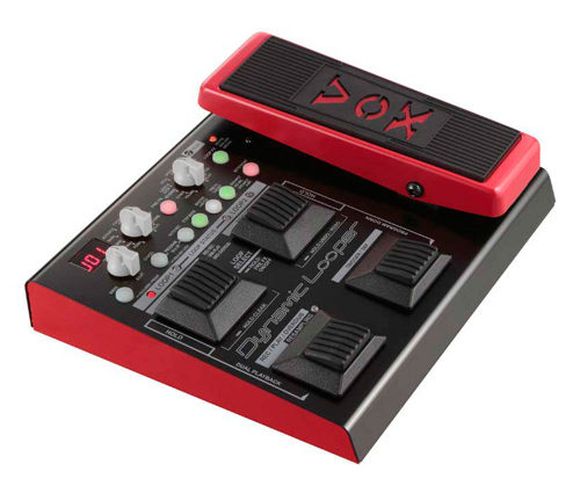3. Further features
One of the advantages of a looper is that the musician need not determine in advance at which speed they will play back or how long they will record: recording is initiated and ended by pressing the foot switch, and this time frame then serves as the rhythmic (tempo) reference for further overdubs and live playing.
But if you like tempo assistance, you'll not be wanting: every looper features at least one integrated metronome function, which often even specifies the tempo using simple drum loops or even an elaborately produced song structure. Line6's JM4, for example, resembles a compact production sequencer in this respect: the tracks pre-produced for this device have been recorded by renowned session musicians, according to Line6 - so you'll have to make sure you not only keep up with the tempo, but also with the musical quality!

Line6 JM4
The integration of pre-produced loops via SD card or USB that we mentioned above also offers the possibility of simulating entire band set-ups on your own: you an do this particularly elegantly on fully-fledged loop stations such as the Boss RC-300, which can play back up to three stereo loops synchronously. Every loop can be added, removed, and controlled individually, so that the loop background, often maligned as monotonous, can easily become an artistically sophisticated backdrop. Imagine: loop station 1 is assigned to the drum section, while unit 2 releases the bass and unit 3 fires other instrumental harmonies into the loop. And then, once you've individually - and synchronously - started off the three units, you can launch overdubs on top, always with a smug smile on your face! Your audience will. love. it.

JamManSolo Flash Card
The looper's possible applications crucially depend on the connection technology and the special features the various manufacturers equip their devices with. Apart from the classic jack connection, which predominantly lends itself to use with an instrument effects board, devices such as the Digitech JamMan Stereo or the Vox VDL1 allow for connecting a vocal mic , which automatically makes it attractive to team beatbox. Ambitious vocal percussionists can sample a scat beat, overdub the bass and harmony parts, and then rap or sing on top of it, which is deeply impressive when the artist knows what they are doing.
The possibilities are even more unlimited if the looper comes with its own battery of useful effects. Instrumentalists may be particularly interested in the Vox devices Lil Looper and VDL1 or the Line6 JM4: these devices offer top-sound amp similations which provide the typical sound of an amp-speaker combination at the touch of a button. For example, you can bring in the first basic bars with a clean class-A sound and then add the overdubs with heavy-metal-y power sounds on top. The looper connects straight to the mixing desk; almost no schlepping involved.

Vox Dynamic Looper
But loopers are no strangers to classic modulation and delay effects, either: apart from a delay, which is part of any looper's bag of tricks, a loop station usually offers the entire arsenal of modulation effects from flanger via chorus to phaser, and room simulation, too. Filter, scrub, stutter or pitch effects are particularly hip, of course, since they allow the musician to raise their performance's club attitude. Even the Boss RC-30, a device conceived more for use in live gigs, leaves nothing to be desired in this respect.
Talking of pitch: when loopers change the pitch of a loop, this must not affect the tempo in any way, otherwise the loop would be ruined. This is why you can even vary the harmonic structure of a loop towards a song structure using the pitch or transpose function.
Conversely, devices such as the Digitech JamMan Delay also allow to decelerate or accelerate the tempo of a phrase while maintaining the pitch. Only a computer offers greater flexibility.




